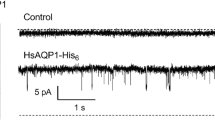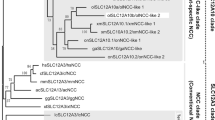Abstract
A water channel, the frog aquaporin-CHIP (FA-CHIP) was recently cloned from Rana esculenta urinary bladder. The 28.9 kDa encoded protein shows 78.8%, 77.4%, 42.4% and 35.6% identity with rat CHIP28, human CHIP28, rat WCH-CD and γ-TIP, other members of the new transmembrane water channel family (Aquaporin-CHIP). We have now studied membranes from different frog (R. esculenta) organs employing semiquantitative PCR using FA-CHIP specific primers and an internal standard to quantify the PCR products. The FA-CHIP mRNA was abundantly expressed in the frog urinary bladder, skin, lung and gall bladder, while a lower expression was detected in the colon, liver and oviduct. FA-CHIP mRNA was not detected in the frog kidney, erythrocytes and brain but its expression was observed in the toad (Bufo arenarum) urinary bladder and skin, showing that FA-CHIP is probably a general amphibian water channel. Salt acclimation is known to increase the water permeability of frog and toad epithelia. We have now observed that salt acclimation for 1, 3, 4 or 5 days markedly increased skin and urinary bladder FA-CHIP mRNA expression. It is generally accepted that water permeability is controlled in these tissues by the rate of water channel transfer from subapical vesicles (aggrephores) to the apical membrane. Our results indicate that water permeability is also regulated at the level of the FA-CHIP transcription.
Similar content being viewed by others
References
Abrami, L., Simon, M., Rousselet, G., Berthonaud, V., Buhler, J.M., Ripoche, P. 1994. Sequence and functional expression of an amphibian water channel, FA-CHIP: a new member of the MIP family. Biochim. Biophys. Acta 1192:147–151
Agre, P., Preston, G.M., Smith B.L., Jung, J.S., Raina, S., Moon, C., Guggino, W.B., Nielsen, S. 1993. Aquaporin CHIP: the archetypal molecular water channel. Am. J. Physiol. 265:F463-F476
Bentley, P.J. 1964. Physiological properties of the isolated frog bladder in hyperosmotic solutions. Comp. Biochem. Physiol. 12:233–239
Brown, D., Grosso, A., De Sousa, R.C. 1990. Membrane architecture and water transport in epithelia cell membranes. In: Membrane transport and information storage. Alan R. Liss, Inc. editor. pp. 103–132
Brown, D., Verbavatz, J.M., Valenti, G., Lui, B., Sabolić, I. 1993. Localization of the CHIP28 water channel in reabsortive segments of the rat male reproductive tract. Eur. J. Cell Biol. 61:264–273
Chevalier, J., Bourguet, J., Hugon, J.S. 1974. Membrane associated particles: distribution in frog urinary bladder epithelium at rest and after oxytocin treatment. Cell Tissue Res. 152:129–140
Chomczynski, P., Sacchi, N. 1987. Single step method of RNA isolation by acid guanidinium thiocyanate-phenol-chloroform extraction. Anal. Biochem. 162:156–159
Deen, P.M.T., Dempster, J.A., Wieringa, B., Van Os, C.H. 1992. Isolation of a cDNA for rat CHIP28 water channel: high mRNA expression in kidney cortex and inner medulla. Biochem. Biophys. Res. Commun. 188:1267–1273
Fushimi, K., Uchida, S., Hara, Y., Hirata, Y., Marumo, F., Sasaki, S. 1993. Cloning and expression of apical membrane water channel of rat kidney collecting tubule. Nature 361:549–552
Gorin, M.B., Yancey, S.B., Cline, J., Revel, J.P., Horwitz, J. 1984. The major intrinsic protein (MIP) of the bovine lens fiber membrane: characterization and structure based on cDNA cloning. Cell 39:49–59
Hasegawa, H., Lian, S.C., Finkbeiner, W.E., Verkman, A.S. 1994. Extrarenal tissue distribution of CHIP28 water channels by in situ hybridization and antibody staining. Am. J. Physiol. 266:C893–903
Katz, U., Ben-Sasson, Y. 1984. A possible role of the kidney and urinary bladder in urea conservation of Bufo viridis under high salt acclimation. J. Exp. Biol. 109:373–377
Ma, T., Frigeri, A., Skach, W., Verkman, A.S. 1993. Cloning of a novel rat kidney cDNA homologous to CHIP28 and WCH-CD water channel. Biochem. Biophys. Res. Commun. 197:654–659
Maurel, C., Reizer, J., Schroeder, J.I., Chrispeels, M.J. 1993. The vacuolar membrane protein γ-TIP creates water specific channels in Xenopus oocytes. The EMBO Journal 12:2241–2247
Moon, C., Preston, G.M., Griffin, C.A., Wang Jabs, E., Agre, P. 1993. The human Aquaporin-CHIP gene. J. Bio. Chem. 268:15772–15778
Nielsen, S., Digiovanni, S.R., Christensen, E.I., Knepper, M.A., Harris, H.W. 1993a. Cellular and subcellular immunolocalization of vasopressin-regulated water channel in rat kidney. Proc. Natl. Acad. Sci. USA 90:11663–11667
Nielsen, S., Smith, B.L., Christensen, E.I., Agre, P. 1993b. Distribution of the aquaporin CHIP in secretory and resorptive epithelia and capillary endothelia. Proc. Natl. Acad. Sci. USA 90:7275–7279
Nielsen, S., Smith, B.L., Christensen, E.I., Knepper, M.A., Agre, P. 1993c. CHIP28 water channels are localized in constitutively water-permeable segments of the nephron. J. Cell Biol. 120:371–383
Preston, G.M., Agre, P. 1991. Isolation of the cDNA for erythrocyte integral membrane protein of 28 kilodaltons: Member of an ancient channel family. Proc. Natl. Acad. Sci. USA 88:11110–11114
Preston, G.M., Carroll, T.P., Guggino, W.B., Agre, P. 1992. Appearance of water channel in Xenopus oocytes expressing red cell CHIP28 protein. Science 256:385–387
Ripoche, P., Parisi, M., Bourguet, J. 1969. Mechanism of the antidiuretic hormone-like action of hypertonic media on the frog urinary bladder. Biochim. Biophys. Acta 193:231–234
Smith, B.L., Baumgarten, R., Nielsen, S., Raben, D., Zeidel, M.L., Agre, P. 1993. Concurrent expression of erythroid and renal aquaporin CHIP and appearance of water channel activity in perinatal rats. J. Clin. Invest. 92:2035–2041
Van Der Goot, F., Corman, B., Ripoche, P. 1991. Evidence for permanent water channels in the basolateral membrane of an ADH-sensitive epithelium. J. Membrane Biol. 120:59–65
Verbavatz, J.M., Frigeri, A., Gobin, R., Ripoche, P., Bourguet, J. 1992. Effects of salt acclimation on water and urea permeabilities across the frog bladder: relationship with intramembrane particle aggregates. Comp. Biochem. Physiol. 4:827–833
Wade, J.B. 1980. Hormonal modulation of epithelium structure. In: Current topics in membranes and transport. F. Bronner, editor. pp. 123–147. Academic Press, New York
Zhang, R., Skach, W., Hasegawa, H., Van Hoek, A.N., Verkman, A.S. 1993. Cloning, functional analysis and cell localization of a kidney proximal tubule water transporter homologous to CHIP28. J. Cell Biol. 120:359–369
Author information
Authors and Affiliations
Rights and permissions
About this article
Cite this article
Abrami, L., Capurro, C., Ibarra, C. et al. Distribution of mRNA encoding the FA-CHIP water channel in amphibian tissues: Effects of salt adaptation. J. Membarin Biol. 143, 199–205 (1995). https://doi.org/10.1007/BF00233448
Received:
Revised:
Issue Date:
DOI: https://doi.org/10.1007/BF00233448




